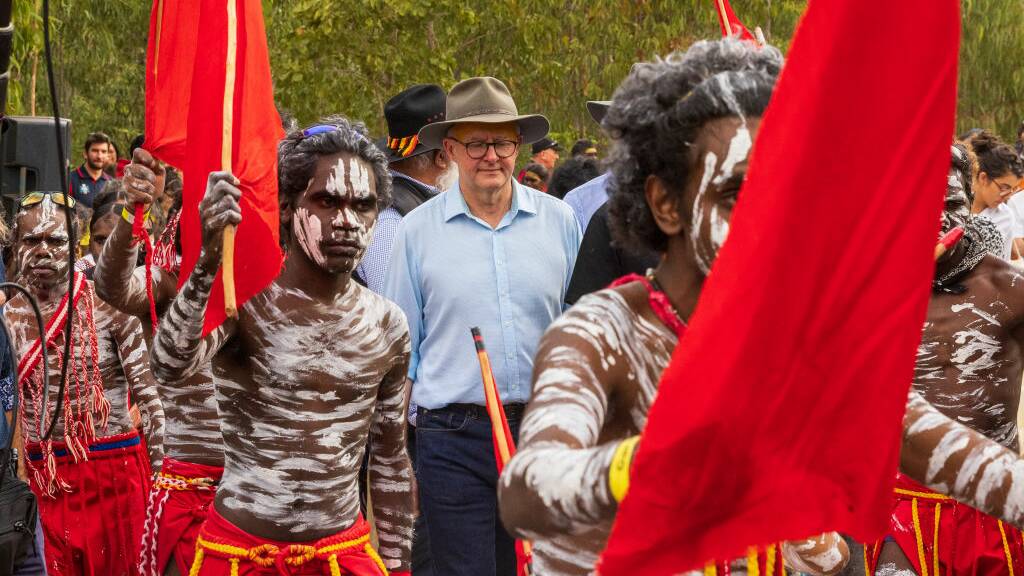
The proposed referendum on an Indigenous Voice to Parliament is very different from the 1999 republic referendum, though there are some important similarities. Nevertheless, referendum history, especially the republic referendum defeat, frames the emerging debate and casts a shadow over its prospects of success.
Subscribe now for unlimited access.
$0/
(min cost $0)
or signup to continue reading
The shadow is not so great as it was when Malcolm Turnbull, personally scarred by the 1999 defeat, rejected a Voice to Parliament when he was prime minister. But past difficulties in passing referendums - no success at all since 1977 and a less than one in five success rate overall - blunts government ambition.
Anthony Albanese has risen above the mire into which the implementation of the Uluru Statement from the Heart had sunk to project an achievable "big picture" vision for Australia. Just as he was an unlikely Labor leader to lead his party back into office from its shattering 2019 electoral defeat, he may become the least likely Labor prime minister to lead his country forwards on this occasion.
Paul Keating was defeated before he was able to test his republican vision. Kevin Rudd lost the prime ministership before he was able to achieve climate action. The humbler Albanese style may be made for this occasion.
The government has no desire either to look backwards to the republic referendum or to look sideways to climate action. That would just raise complications. The Voice must stand alone. New bipartisan alliances must be built, including with monarchists and climate sceptics, to create a substantial majority for change.
But there are similarities. One is trajectory. Just as Albanese celebrates the 1967 Indigenous referendum success, the 1992 Mabo judgement, and the 2007 Apology by Rudd to the stolen generations, Keating built on the gradual decoupling of Australia from Britain, including moving on from the Privy Council, British governors-general, and God Save the Queen as the Australian national anthem, culminating in the 1986 Australia Act which cut remaining constitutional ties with Britain. But a positive trajectory did not guarantee ultimate republican referendum success.
Another similarity is the perception of a tension between big picture constitutional change and practical reform. Denigration of symbolic change dogged the republic cause, leading to the frequent question from the unconvinced, "What's the practical benefit?". Opposition Leader Peter Dutton has tried to explain his failure to support the 2007 Apology with reference to his preference for practical reforms. Opposition Indigenous Senator Jacinta Nampijinpa Price opposes the Voice referendum for similar reasons.
Republicans tried to link constitutional change to practical benefits for the nation through independent trade and foreign policies. Advocates of the Voice stress the ultimate, if not immediate, practical benefits for Indigenous communities through this new link with parliament.
A further similarity is the impact of proposed constitutional structural change on traditional Westminster democracy and the authority of the government to govern. Republicans faced the charge that the Westminster system would be damaged if the role of prime ministerial government was undermined by a president with a competing mandate. Advocates of the status quo claimed that this would create confusion and diminish accountability.
Some early opposition to the Voice was in the same vein. There were initial claims that the Voice should be rejected because it would be a third house of parliament, inevitably cutting across the roles of the elected House of Representatives and the Senate.
MORE JOHN WARHURST:
The biggest emerging similarity between the two referenda is the constant demand by the media and some opponents for greater detail before the referendum vote is taken. More information always sounds like a benign and innocuous request, but as republicans found it can be as dangerous as quicksand. It explained the preference of many republicans for a prior plebiscite, rather than a referendum, to set the broad direction first. Not only does more detail quickly produce division between supporters, but it also alienates and confuses some people. Community ignorance about such matters is widespread. Constitutional provisions make for dry discussion, quite the opposite of the popular momentum needed for constitutional change to be successful. "If you don't know, vote NO" was a powerful campaign weapon in 1999.
Albanese has suggested a broad wording for the referendum question, "Do you support an alteration to the constitution that establishes an Aboriginal and Torres Strait Islander Voice?", which sounds very much like a plebiscite question. He defends this approach as providing a clear and simple framework to give the conversation "shape and direction". He has also suggested that three sentences would be added to the constitution if the referendum succeeded, setting up the body in question, its broad role, and the role of the parliament in respect to it.
When Albanese says that "We are seeking a momentous change, but it is also a very simple one" he is both telling the truth and underplaying the significance of the proposal. His task will be to sell the proposed change to the wider community as a simple yet momentous step forward whose time has come. His initial statement at the Garma Festival provided the framework for such a positive campaign, stressing his belief that "there is room in Australian hearts for the Statement from the Heart" and expressing his confidence that the community would take this "magnificent opportunity."
Prime minister John Howard opposed the republic, but Albanese supports the Voice. His attractive vision has every chance of capturing the hearts of a broad cross-section of the Australian community. Past referendums show, however, that descent into divisive arguments about detail can lead to failure.
- John Warhurst is an emeritus professor of political science at the Australian National University and a regular columnist.


